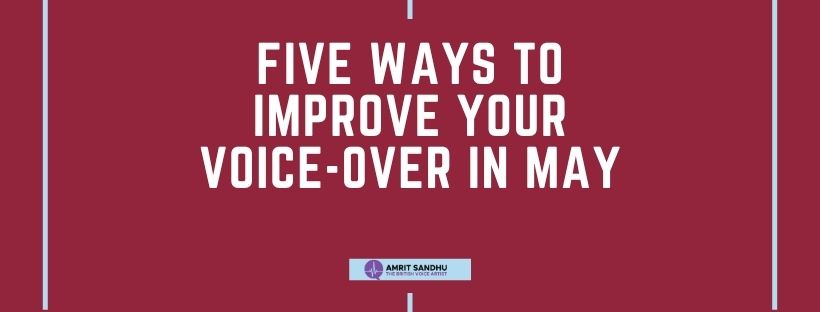Hey voice actors! May is here, and with it comes the perfect opportunity to refresh your skills and take your voiceover career to the next level. Instead of getting bogged down in overwhelming to-do lists, let’s focus on five key areas for improvement this month. These actionable steps will help you polish your craft, attract more clients, and ultimately, boost your success.
1. Conquer Your Vocal Warm-Ups: The Foundation of Great Voice Acting
We all know we should warm up our voices before recording, but how many of us actually do it consistently and effectively? May is the month to make vocal warm-ups a non-negotiable part of your routine. Think of it as pre-flight checks for your vocal instrument. Neglecting this crucial step can lead to vocal strain, inconsistent performance, and even injury.
– Beyond the Basics: Move beyond simple humming. Incorporate tongue twisters to improve articulation (“Peter Piper picked a peck of pickled peppers”), lip trills to loosen your lips, and scales to expand your vocal range. Experiment with different vowel sounds and consonant combinations.
– Targeted Warm-ups: Consider the type of voiceover work you’ll be doing. If you’re recording a dramatic audiobook, you’ll need different warm-ups than if you’re recording a cheerful commercial. Tailor your routine to the specific demands of the project.
– Consistency is Key: The key to effective warm-ups isn’t just doing them, but doing them consistently. Make it a habit, even if you only have a few minutes. A short, focused warm-up is better than no warm-up at all. Aim for 5-10 minutes before each recording session.
– Listen to Your Body: Pay attention to how your voice feels. If something feels strained or uncomfortable, stop and adjust your technique. Don’t push yourself too hard, especially when starting out.
2. Master the Mic Technique: Bridging the Gap Between Performance and Recording
Your vocal performance is only half the equation. Proper microphone technique is crucial for capturing a clear, professional-sounding recording. Many voice actors overlook this, resulting in subpar audio quality that can hinder their career progress.
– Microphone Placement: Experiment with different microphone placements to find what works best for your voice. Generally, a close-miking technique (placing the microphone a few inches from your mouth) is preferred for voiceover work, minimizing background noise and maximizing clarity.
– Distance and Angle: Maintaining consistent distance and angle is key to preventing volume fluctuations and unwanted pops and plosives. Consider using a pop filter to minimize plosives (the harsh sounds created by “p” and “b” sounds).
– Body Awareness: Be mindful of your body position. Avoid unnecessary movement that could create unwanted noise. Maintain a relaxed posture to ensure consistent breath support and vocal delivery.
– Experiment and Refine: Recording yourself is crucial for understanding how your voice sounds through the microphone. Experiment with different techniques, listen back critically, and refine your approach based on what you hear.
3. Elevate Your Script Preparation: Unlocking the Power of Understanding
A well-prepared script is the foundation of a compelling voiceover performance. Don’t just read the words; understand the context, the message, and the intended audience.
– Beyond the Words: Read the script multiple times, paying attention to the nuances of the language, the underlying emotions, and the overall message. Consider the target audience and the desired impact.
– Character Development: If you’re voicing a character, spend time developing their personality, background, and motivations. This will help you bring the character to life with your voice.
– Marking the Script: Mark your script with notes on pacing, intonation, and emphasis. Highlight key words and phrases that require special attention. This will help you deliver a more nuanced and engaging performance.
– Practice, Practice, Practice: Practice reading the script aloud multiple times before recording. This will help you become comfortable with the material and deliver a smooth, confident performance.
4. Embrace the Power of Feedback: Unlocking Hidden Potential
Seeking feedback is often overlooked, but it’s an invaluable tool for growth. Constructive criticism, even if it’s difficult to hear, can highlight areas for improvement and accelerate your progress.
– Find Your Critics: Identify trusted individuals who can provide honest and constructive feedback on your voiceover work. This could be a mentor, a fellow voice actor, or a trusted friend with a good ear.
– Specific Feedback: Ask for specific feedback on your technique, your delivery, and your overall performance. Don’t be afraid to ask pointed questions to gain a deeper understanding of areas for improvement.
– Embrace the Criticism: Don’t take criticism personally. Use it as an opportunity to learn and grow. Focus on the specific points raised and develop strategies to address them.
– Regular Feedback Sessions: Make feedback sessions a regular part of your workflow. This will help you stay accountable and continually refine your skills.
5. Expand Your Network: Building Connections for Success
Networking is crucial for success in any field, and voice acting is no exception. Building connections with other professionals can open doors to new opportunities and collaborations.
– Online Networking: Engage actively on social media platforms, participate in online forums and groups, and connect with other voice actors and industry professionals.
– Industry Events: Attend voiceover conferences, workshops, and networking events to meet people in person and build relationships. – Collaboration: Collaborate with other voice actors on projects to gain experience and expand your network.
– Mentorship: Seek out mentorship from experienced voice actors to gain valuable insights and guidance.
By focusing on these five key areas this May, you’ll be well on your way to significantly improving your voiceover skills and achieving your career goals. Remember, consistent effort and a willingness to learn are the keys to success. Happy recording!




